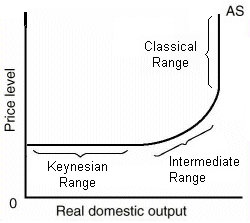AP Macroeconomics Unit 4 - Part 1
·
Types
of money:
1.commodity money- A good that has other purposes that also
functions as money. Ex. Cows as money (MOST PREMATIVE)
2. Representative money- whatever you use as currency,
represents a specific quantity of a precious medal. (gold Standard) drawback,
value of the medal changes, effects value of currency.
3.Fiat money- money that is not backed by precious medal,
legal tender, money must be accepted by transactions, value backed by the
government.
·
Functions
of money:
1.Medium of exchange- through money that exchanges happen.
2.Store of value- expect money to be stable. Putting money
aside.
3.Unit of account-priceàworth
(quality) ex. Named Brands
|
AP Macroeconomics Unit 4 - Part 3
|
·
price-
interest rate (X axis)
·
Quantity-
Y Axis
·
Demand
slopes down (DM-demand for money)
·
Supply
of money is vertical (Fixed unless FED moves it)- doesn’t vary on interest rate
·
FED
government tax credit for 1st home buyer- increase demand for money
-When you increase demand you put upward pressure on
interest rate
·
if
FED wants to bring interest rate down, shift the supply of money to the right.
·
FED
want to stabilized interest rate, if not then you cannot predict the level of
investment and the level intransitive consumer spending, thus not able to
manipulate aggregate demand to give you the right kind of economic change at
the time.
|
AP Macroeconomics Unit 4 - Part 4
|
·
The
FED: Tools of Money Policy-
|
Expansionary
(Easy Money) increase
|
Contractionary (Tight
Money) decrease
|
|
|
Reserve Requirement
|
Lower it
|
Raise it
|
|
Discount rate
|
Lower it-
Doesn’t mean banks will borrow money (an Incentive)
|
Raise it
|
|
(Most Used) Buy/Sell
gov’t bonds/ securities
|
FED buys
bonds
(buy
bonds= Big bucks)
|
FED sells
Bonds
(FOMC does this)
|
·
Discount
rate- the rate at which banks can borrow money from the FED.
Why? Short term- bank needs to meet its liquidity need.
·
Function
of the FED- Lender as a last resort.
·
Federal
Funds Rate- rate a which banks borrow money from each other.
AP Macroeconomics Unit 4- part 7
- When the interest rate is low people demand more money and when the interest rate is high people get discouraged from borrowing money.
- Decrease in supply it reduces the national supply of loanable funds it decreases amount available in savings.
- The money people save becomes more money for the banks to use as loans.
- Increase in demand for loanable funds increases the interest rate.
- In the money creation process banks create money by making loans.
- More money is made due to multiplier deposit expansion and adding loans would give the same amount of money if we don't use excess reserves.
- If a certain amount of money is deposited into a bank than the bank can loan less money until there isn't any more money left from that original deposit.
- By adding the all the loans given you get your potential total increase
- In deficit spending government borrows money from americans.
- In a MKT graph demand for money increases in interest rates.
- When the demand for money increases national supply in loanable funds is reduced.
- The Fisher effect is the rule of interest rate and inflation rate being equal to each other





